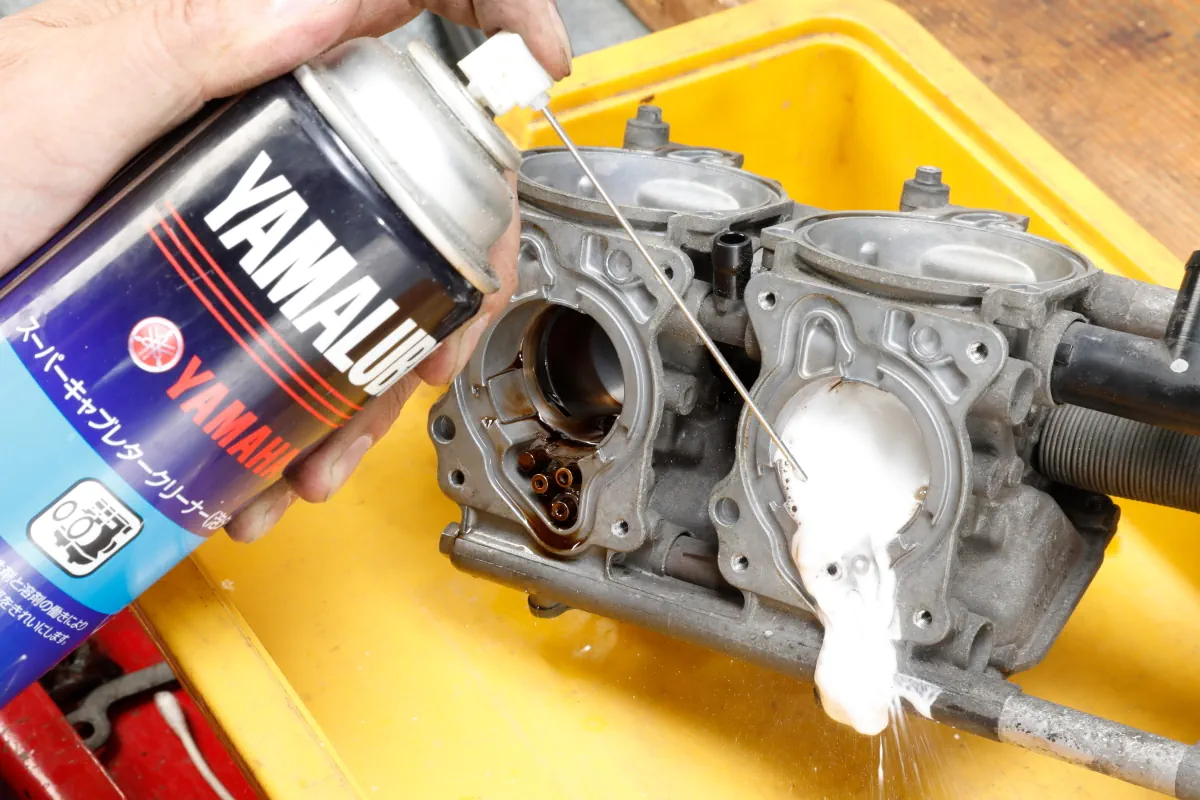Carburetors can change the fuel in the float chamber in as little as a few months. An overhaul is essential to remove dirt and debris clogging the jets and passages. At that time, multi-carburetors with two or more cylinders also needed to check the condition of the O-rings in the fuel passages = fuel joints. In the case of discontinued motorcycles that have been out of production for a long time, it is unconditionally recommended to replace them.
- Carburetors dirty with carbon and varnish need to be overhauled and refreshed.
- Drying hardening due to running out of fuel causes leakage from the O-ring area.
Carburetors dirty with carbon and varnish need to be overhauled and refreshed.


If the inside of the carburetor is suspected to be dirty due to long-term neglect, replace the fuel in the float with new fuel and try to start the car.
Deteriorated fuel begins to clog in narrow areas, so the pilot system, which is critical for idling, is often the first to malfunction.


After removing all parts that can be removed from the body, such as jets and vacuum pistons, spray the carburetor cleaner evenly over the holes. After allowing the cleaner to penetrate, rinse with parts cleaner and check that each passageway has been penetrated by blowing air through it.
If the starting performance of a carbureted car deteriorates after only a few months of not being driven, the symptoms may be corrected by draining the fuel from the float chamber and replacing it with fresh fuel for now. The deterioration of fuel varies depending on storage conditions. Some manufacturers state on their websites that storage in a cool, dark place with little change in temperature for about six months will have little effect on quality, but we recommend using fuel as soon as possible because the degree of deterioration varies depending on conditions such as storage temperature, humidity, and contact with the air.
If the bike is not ridden for a long period of time for various reasons, the fuel inside the carburetor can deteriorate and become varnished, and if moisture is present, the jets and needles can corrode. If this happens, it is more likely that the bike will not start when the fuel in the float chamber is replaced. This is because if the jets are clogged, fuel will not flow into the venturi and will not be mixed. When this happens, disassemble the carburetor, remove the needle and jet, and clean it with carburetor cleaner. Deteriorated fuel affects not only the jets but also the entire carburetor interior, so when using carburetor cleaner, it is important not only to spray it on the dirty surface but also to inject it thoroughly into the fuel and air passages inside the carburetor.
Drying hardening due to running out of fuel causes leakage from the O-ring area.


An example of fuel leaking from a fuel joint connecting two carburetor bodies. After draining fuel from the float chamber and storing it for several years, fuel flowed from the fuel hose and gradually seeped out from the back of the joint. In the case of an overflow caused by a poorly closed float valve, fuel flows out of the overflow pipe at the bottom of the float chamber, but leaks from the fuel joint are different because the fuel drips from above the surface where the float chamber and body meet.
In addition to cleaning the jets, needles, and passages inside the body with carburetor cleaner, it is also necessary to check the fuel joints in the case of multi-cylinder carburetors. For 4-cylinder carburetors, there are two types of fuel hoses leading from the fuel cock to the carburetor: one or two hoses. If one hose is used, fuel is diverted from one hose to the float chambers for the four cylinders at the joint. If there are two hoses from the fuel cock, each hose leads to a float chamber for two cylinders each. In either type, the fuel joint is located outside the carburetor body, and an O-ring is set at the insertion point into the body to prevent fuel leakage. Some out-of-print cars do not use O-rings because the entire joint is coated with a rubbery coating. If these O-rings deteriorate over time, fuel can leak from the gap between the fuel joint and the body.
Fuel leaking from the carburetor is often thought to be caused by overflow inside the float chamber, but if fuel has been drained from the fuel joint on a motorcycle that has not been used for a long time, the O-rings that have not been in contact with fuel will harden and develop small cracks, and there is a risk of leaking when fuel is added after overhauling There is a risk of leaking when fuel is added afterward. Cracks and deterioration of the O-rings progress while fuel is still flowing in the fuel joint, but once the fuel dries up, the rubber shrinks and the cracks enlarge, or the pattern is more likely to start leaking.